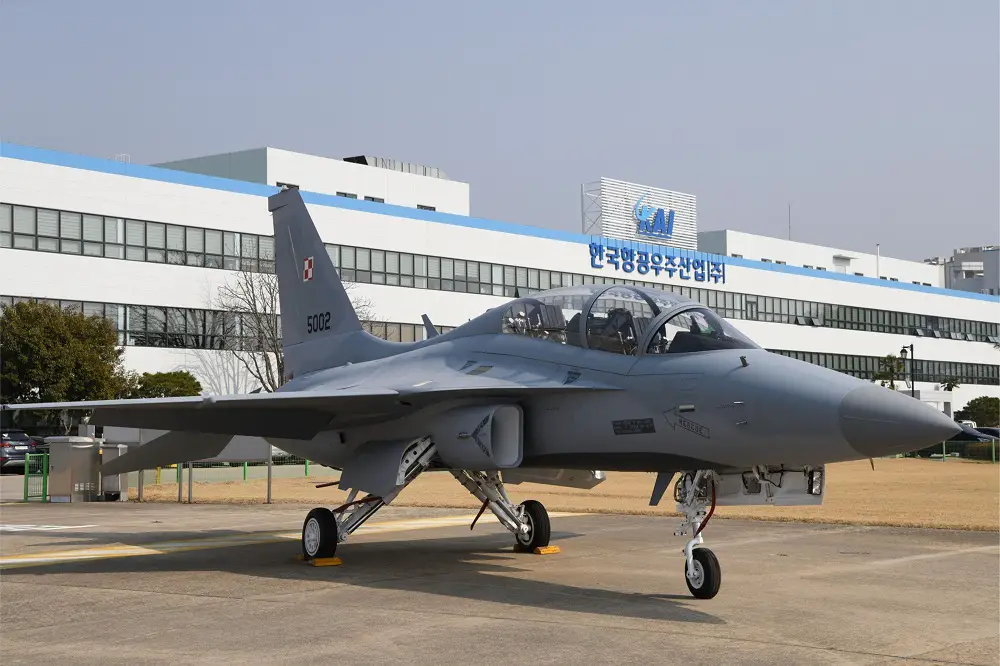The South Korean Ministry of Trade, Industry and Energy (MOTIE) has unveiled a strategy to support the enhancement of the Korea Aerospace Industries (KAI) FA-50 light trainer and attack aircraft by developing a single-seat variant. MOTIE’s initiative also includes integrating a domestically produced Automatic Ground Collision Avoidance System (GCAS) into the FA-50. On May 3rd, the ministry disclosed a plan to allocate KRW 49.4 billion (approximately USD 36.39 million) in collaboration with KAI for the development of the single-seat version. This project aims to bolster the FA-50’s competitiveness in the global market and diversify the nation’s export capabilities. The government plans to invest KRW 29 billion in the program from 2024 to 2028, with KAI and other partner countries contributing the remaining funds.
MOTIE clarified that this development initiative involves modifying the airframe for a single-seat configuration and incorporating an auxiliary fuel system to extend the operational range by up to 30%. KAI intends to execute the single-seat variant by eliminating the second cockpit and pilot and installing a 300-gallon auxiliary fuel system in that space. During the Singapore Airshow in February 2023, a KAI representative informed Janes that this modification could potentially increase the aircraft’s operational range by up to 20%. Further tests are being conducted by KAI to ascertain the precise extent of this enhancement. Currently, the FA-50 has a radius of action of 239 nautical miles in a hi-lo-lo-hi configuration.

The FA-50 is a light combat aircraft manufactured by KAI for the Republic of Korea Air Force (ROKAF). It is a light combat version of the T-50 Golden Eagle supersonic advanced jet trainer and light attack aircraft. It is South Korea’s first indigenous supersonic aircraft and one of the world’s few supersonic trainers. Development of the T-50 began in the late 1990s, and its maiden flight occurred in 2002. It entered active service with the Republic of Korea Air Force (ROKAF) in 2005. The T-50 has been further developed into aerobatic and combat variants, namely T-50B, TA-50, and FA-50. The T-50B serves with the South Korean air force’s aerobatics team. The T-50 variant resembles the F-16 Fighting Falcon, though it is only 80% of the size. The T-50 uses a single General Electric F404-102 turbofan engine license-produced by Samsung Techwin, upgraded with a FADEC system jointly developed by General Electric and KAI
The FA-50 boasts versatile capabilities and is equipped with high-performance avionics including an EL/M-2032 doppler radar pulse for the TA-50 and FA-50 Block 10, or the Raytheon PhantomStrike AESA for the Block 20 version. The FA-50 has a three-barrel cannon based on the M61 Vulcan mounted internally behind the cockpit, which fires linkless 20 mm ammunition. Wingtip rails can accommodate the AIM-9 Sidewinder missile, and a variety of additional weapons can be mounted on underwing hardpoints. Compatible air-to-surface weapons include the AGM-65 Maverick missile, Hydra 70 and LOGIR rocket launchers, CBU-58 and Mk-20 cluster bombs, and Mk-82, ?83, and ?84 general-purpose bombs. European missile maker MBDA’s Meteor and ASRAAM medium and short-range air-to-air missiles are also reportedly available for integration on the FA-50. Considering its commendable performance, the KAI FA-50 presents a compelling proposition when weighed against its price. Priced at around $45 million by KAI, the FA-50 Block 20 is 35% cheaper than a Swedish JAS 39 Gripen D and 50% cheaper than an F-16.















